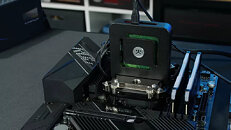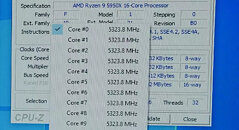Monday, November 16th 2020

Der8auer Tries Out Intel's TEC Cooler on an AMD Ryzen 9 5950X
Der8auer has picked up Intel's latest TEC cooler, built in conjunction with EKWB, and unceremoniously plopped it right into an AMD Ryzen 9 5950X CPU. Well, not completely unceremoniously - there were many accommodations that had to be made in order to achieve this. For one, as this is a solution designed specifically for Intel CPUs and sockets, Der8auer had to Frankenstein his way through a number of cooling parts to be able to adapt the TEC solution to the AM4 socket. Not only that, but Intel's TEC requires deep software control for it to work properly - software control which only works with Intel silicon, of course. Der8auer thus had to have a second machine running an Intel 10900K CPU to control the software on the Intel cryo cooler.
All in all, the results were interesting, to say the least. The 16-core, 32-thread Ryzen 9 5950X saw single-core-load CCD temperatures in the 90 °C department with the TEC solution disabled - which promptly dropped down to only 50 °C with the cryo cooler actually operating. With a game load, the 5959X achieved up to 5.050 GHz in single-cores on its automatic boost profile. The entire chip often boosted to 4.8 - 4.9 GHz on all cores at once (with variances between the CCDs) whilst under this cooling solution and workload. With the TEC operating in its unregulated mode - which means, with no considerations for CPU operating temperature and power usage for the cooling process - saw the Ryzen 9 5950X achieving 2 °C core temperature results, and boosted frequencies up to a staggering 5323 MHz on all cores - before crashing. An interesting piece of work which you catch on video after the break; one can rest assured that most PC cooling specialists are already working on their own TEC-based cooling solutions following Intel's achievement in this field.
Source:
via Tom's Hardware
All in all, the results were interesting, to say the least. The 16-core, 32-thread Ryzen 9 5950X saw single-core-load CCD temperatures in the 90 °C department with the TEC solution disabled - which promptly dropped down to only 50 °C with the cryo cooler actually operating. With a game load, the 5959X achieved up to 5.050 GHz in single-cores on its automatic boost profile. The entire chip often boosted to 4.8 - 4.9 GHz on all cores at once (with variances between the CCDs) whilst under this cooling solution and workload. With the TEC operating in its unregulated mode - which means, with no considerations for CPU operating temperature and power usage for the cooling process - saw the Ryzen 9 5950X achieving 2 °C core temperature results, and boosted frequencies up to a staggering 5323 MHz on all cores - before crashing. An interesting piece of work which you catch on video after the break; one can rest assured that most PC cooling specialists are already working on their own TEC-based cooling solutions following Intel's achievement in this field.


26 Comments on Der8auer Tries Out Intel's TEC Cooler on an AMD Ryzen 9 5950X
Also given power consumption and power cost, doubt many want to run OCed CPUs for long time.
Its nice and cute, as much as is multi-stage phase change, but.. in the end, its good for record and nothing else.
I played around with some on an 8700K, gave low idle temps as you would expect but load temps were horrible, the custom water loop alone gave better temps.
The amount of media exposure for these contraptions lately is kind of funny really. Just shows how technically illiterate the tech media 'journalists' are these days.
:roll: :roll: :roll:
On xtremesystems.org you can still find a category devoted to TECS. Some very old threads showed some nuked TEC's while running on a 24/7 setup. If you have a heat source, you could however extract free power from it. You simply reverse the proces where the hot side is being heated; and the cold side is being cooled. This generates a small voltage and when paired enough you got some form of free energy.
But tec's are very bad in that respect; very low efficiency as well. They power the Voyager I and II, which is a sattelite in space that has a power estimation for over 40 years due to nuclear reaction. The heat is being converted into power for the sattelite. Now thats putting a tec to good use.
www.techpowerup.com/forums/threads/sexy-hardware-close-up-pic-clubhouse.71955/post-986906
Sorry, but I will never understand that logic. Like those who buy small and cheap cars and then spends all their money with spoilers, paint, tuning...
Sorry Bauer, der musste sein ;) … Trotzdem interessant und danke für den Test :D